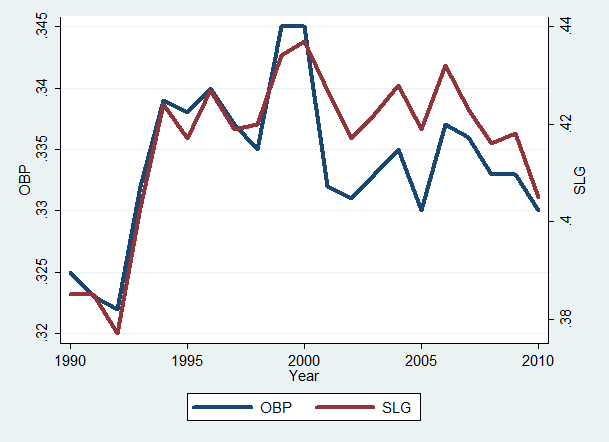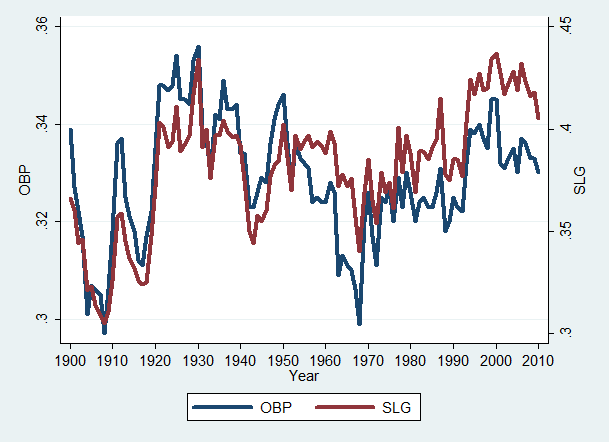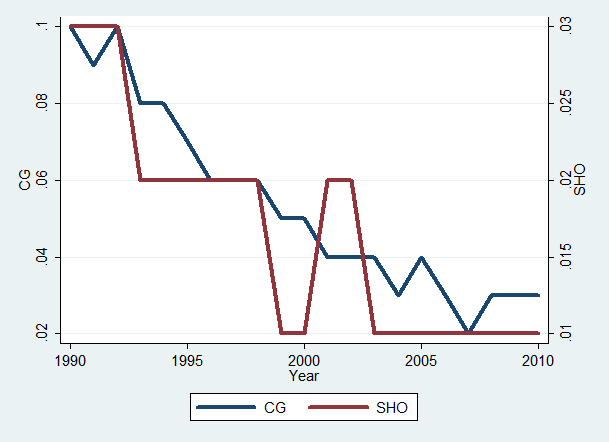The Year of the Pitcher? A Holistic Analysis
Thus far, the Year of our Sport 139 — or the Year of our Lord 2000 and 10 — curious whispers have grown to sly murmurs, and in unity they portend: the Year of the Pitcher. Already, fans have indulged in the sight of two perfect games and a third de facto perfect game. By contrast, this time last season, we fans were discussing Albert Pujols’ interminable Power and Joe Mauer’s surprising Pop, all the while swirling the snifter of Slugging; but this year, tales of a Resurgent Carlos Silva and the dazzling Kid Stephen Strasburg have seized our headlines. This, the media assures us, is the Year of the Pitcher.
But is it? Perhaps it is the year of the Pat Burrell — the aging slugger — or perhaps the year of the missing needle? One thing is certain: Our teams are scoring fewer runs. The 2010 MLB’s runs per game has reached pre-Clinton lows:
Of course, taken with a tankard of greater perspective, this recent descent does not appear too outrageous. It in fact puts us closer in line with historical performances:
Looking at this graph makes it hard for one to not suspect we are nearing a new Dead Ball Era dip, but I warn readers to avoid such a conclusion (the context of the Dead Ball Era is completely unlike our own; from rules to stadiums, the sport has changed too immensely to return to that era).
Nonetheless, the recent downward trend must source somewhere. Homeruns are down, but not down that much:
Intriguingly, Power did not depart alone, but seems to have taken a constitutional with its counterpart, Patience. These partners in offense have taken a recently unprecedented dip this year:
However, perspective again rewards us. Indeed OBP and SLG are down, but both remain near their highest points since 1900:
From this angle, is almost seems silly to anoint pitchers the winners of our First Annual Who’s Playing Better Than Their Teammates Award. Especially if we consider the steady decline in wholly dominant starting performances. Over the last 20 years, pitchers have thrown increasingly fewer complete games and complete game shutouts (per game):
Granted, stricter pitch count limits and increasing hitter talent (or “talent,” for those that wish it) play a large function in this trend. Still, CGs have decreased almost 80% while pitch count limits have only gone from 150 (in the most drastic cases) to 110 (or ~30%).
Also, despite the downturn in total runs, the fleet-footed have prospered:
Note the increased gap between bases stolen and thieves caught. It is approaching a success rate unseen since General Eisenhower was kissing babies on the campaign trail.
So what is going on? If hitters are doing worse, base-thieves are prospering, and pitchers aren’t splintering bats and melting mitts, then why on earth have run totals gone down?
Well, pitchers might be pitching better — I never said they were doing worse, that was your faulty assumption, dear reader. Although, I doubt such is the case — I doubt that pitchers have suddenly thrust a defiant finger in the air and decided to pitch better, or that hitters have gotten tired of swinging hard. At the same time, I do not feel the current crop of pitching or hitting talent has changed significantly enough from what it was 3 or 4 years ago to explain the sudden shift.
Reasons that I think are reasonable include:
1) Random Fluctuation: Either the hitters are still catching up to pitchers (as your friend and mine, Joe Pawlikowski suggested) or the league collectively has an unusually high xFIP and LOB% or low BABIP.
Take, for instance, how the season’s first perfect game came from a merely above average pitcher, Dallas Braden, against the genuinely dangerous and potent offense of the league’s current best team. Such a feet cannot be anything but random.
2) The Fade of the Steroid Era: Because it is already too discussed and too vilified, I’m less inclined to prognosticate on this matter, but I do think the offensive up-tick in 1990 is due to slip into a trough as the rules and culture around performance enhancing drugs continue to harden.
3) A Change in Talent Stock: As mentioned before, it is indeed possible that just the right players are hitting their primes (namely pitchers) while others are fading fast (the Pat Burrell’s and Aramis Ramirez’s of the world). This effect too is hard to quantify and even harder to merely identify.
4) An Increased Appreciation of Defense: Much has been made lately — especially in states abbreviated MA — about the importance of defense. Moreover, the current crop of widely available sabermetric defensive tools has allowed us to finally conk Fielding Percentage over the head with a shovel and bury it discretely in the back yard. However, it is hard to approximate at what time teams began evaluating defense differently, so it is hard to know where the connection would lie. Some pundits claim this year marks the start of a new trend, but doing so — in my opinion — simply undersells the well-assembled defensive teams of the past (such as the Red Sox, circa mid 2000s).
5) Ragnarök: Presumably, Odin has begun his battle with the great wolf, Fenrir, thereby beginning the series of doom events known popularly as Ragnarök. This implies that we can expect the impending deaths of not only Odin and Thor, but also 10-run slug-fests.
Whatever the cause of the recent shifts in run outputs, I think it is most fair to say the year is still too young to declare a winner. Indeed 3 de facto perfect games is nothing at which to sniff, but strangers things have happened:
Brad also writes for Cubs Stats and makes non-hilarious guest appearances on Another Cubs Blog.








Great article, and great graphs as well.
Before I blew up the final graph, I half expected it to be some fictional account of the battle between Thor and Ragnarok.
Ha! I only wish a battle of such magnitude could fit on our mortal graphs.
Thanks for the kind words, Bronnt.
to me, it is also a cycle, because the bats were big, everyone stocked up on pitching.
Look at the AL East, while it used to be thought of as Jeter, A-Rod, Bernie Willians, Manny, Ortiz etc, its now about arms, and young arms.
Teams are working much harder at developing pitching, which links into #3.
Again hard to quantify, the easist way would be Red Sox prospect Casey Kelly, given the choice to continue career as a SS or a pitcher, chose pitcher because it was a quicker path to the big league (he is a better pitcher than SS), but its still a quicker path if both skills are equal.
Excellent points, q.
I definitely think the next step for this study is an analysis of the current pitching talent pool in comparison with past years.